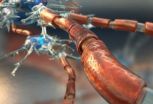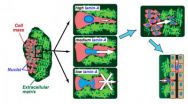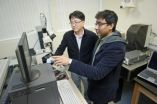(Press-News.org) Washington, DC—Patients were twice as likely to have a diabetic foot ulcer heal within eight weeks when they were treated with a tissue repair drug versus a placebo, according to new research accepted for publication in the Endocrine Society's Journal of Clinical Endocrinology & Metabolism (JCEM).
Foot ulcers are a common complication from diabetes than can lead to hospitalization and lower limb amputation. In 2006, about 65,700 non-traumatic lower-limb amputations were performed in people with diabetes, according to the Centers for Disease Control and Prevention. Up to 85 percent of amputations can be avoided when ulcers are prevented from forming or are treated successfully, said one of the study's authors, Francesco Squadrito, MD, of the University of Messina in Gazzi Messina, Italy.
"Foot ulcers are a dangerous and expensive complication for people with diabetes, and current treatments such as hyperbaric oxygen therapy are costly and can have side effects," Squadrito said. "Our study showed for the first time that a pharmacological approach can improve wound healing in people with diabetes."
In the prospective randomized, double-blinded, placebo-controlled clinical trial, 216 participants with diabetic foot ulcers free of visible infection were assigned to receive either the tissue repair drug polydeoxyribonucleotide (PDRN) or a placebo. Participants received injections of either PDRN or a placebo for eight weeks and were monitored for an additional four weeks for any change in the ulcer.
After two months, 37 percent of the patients who were treated with PDRN had their ulcers completely closed, compared with nearly 19 percent of the patients who received the placebo. Study subjects reported few side effects from PDRN, Squadrito said.
"This approach could revolutionize the treatment of diabetic foot ulcers – a main cause of hospital admissions in the developed world," he said. "An estimated 382 million people worldwide have diabetes, and it is crucial to find effective treatment options for hard-to-heal ulcers and other complications facing millions of patients."
INFORMATION:
Other authors of the study include: A. Bitto, D. Altavilla, V. Arcoraci, G. De Caridi, G. Pallio, C. Sterrantino, L. Minutoli, A. Saitta, M. Vaccaro and D. Cucinotta of the University of Messina; M. E. De Feo of Cardarelli Hospital in Naples, Italy; and S. Corrao of the University of Palermo in Italy.
The study, "The Effect of PDRN, An Adenosine Receptor A2A Agonist, on the Healing of Chronic Diabetic Foot Ulcers: Results of a Clinical Trial," was published online, ahead of print.
Founded in 1916, the Endocrine Society is the world's oldest, largest and most active organization devoted to research on hormones and the clinical practice of endocrinology. Today, the Endocrine Society's membership consists of over 17,000 scientists, physicians, educators, nurses and students in more than 100 countries. Society members represent all basic, applied and clinical interests in endocrinology. The Endocrine Society is based in Washington, DC. To learn more about the Society and the field of endocrinology, visit our site at http://www.endocrine.org. Follow us on Twitter at https://twitter.com/#!/EndoMedia.
Tissue repair drug helps heal diabetic foot ulcers
Study first to find a drug can improve healing rates in people at risk for amputation
2014-02-25
ELSE PRESS RELEASES FROM THIS DATE:
New study presents evidence that blood pressure should be measured in both arms
2014-02-25
Philadelphia, PA, February 25, 2014 – As heart disease continues to be one of the leading causes of death in the United States, practitioners and patients alike are looking for ways to cut risk factors and identify new clues to assist with early detection. New research published in the March issue of The American Journal of Medicine suggests that there is an association between a difference in interarm systolic blood pressure and a significant increased risk for future cardiovascular events, leading researchers to recommend expanded clinical use of interarm blood pressure ...
Ecotoxicity: All clear for silver nanoparticles?
2014-02-25
It has long been known that, in the form of free ions, silver particles can be highly toxic to aquatic organisms. Yet to this day, there is a lack of detailed knowledge about the doses required to trigger a response and how the organisms deal with this kind of stress. To learn more about the cellular processes that occur in the cells, scientists from the Aquatic Research Institute, Eawag, subjected algae to a range of silver concentrations.
In the past, silver mostly found its way into the environment in the vicinity of silver mines or via wastewater emanating from the ...
Georgia Tech project ensures 'what you see is what you send'
2014-02-25
Imagine a user who intends to send $2 to a friend through PayPal. Embedded malware in the user's laptop, however, converts the $2 transaction into a $2,000 transfer to the account of the malware author instead.
Researchers at Georgia Tech have created a prototype software, Gyrus, that takes extra steps to prevent malware from sending spam emails and instant messages, and blocking unauthorized commands such as money transfers.
Current protection programs might recognize the original user's intent to send email, transfer money or engage in other transactions, but cannot ...
Unhealthy attachments
2014-02-25
(Santa Barbara, Calif.) — Using the surface forces apparatus and an atomic force microscope, researchers at UC Santa Barbara have taken a molecular approach to myelin membrane interactions, leading to insights into demyelinating diseases, such as multiple sclerosis. Their research is published in the Proceedings of the National Academy of the Sciences.
For a healthy nervous system, axons — the long projections of our nerve cells that run throughout our bodies — must be properly insulated. Much like conventional power cords need electrical insulators around the conducting ...
Penn researchers show nuclear stiffness keeps stem cells and cancer cells in place
2014-02-25
Adult stem cells and cancer cells have many things in common, including an ability to migrate through tiny gaps in tissue. Both types of cells also experience a trade-off when it comes to this ability; having a flexible nucleus makes migration easier but is worse at protecting the nucleus' DNA compared to a stiffer nucleus. Nuclear proteins that regulate nuclear stiffness are therefore thought to control processes as diverse as tissue repair and tumor growth.
In a study published in the Journal of Cell Biology, researchers at the University of Pennsylvania have shown ...
Climate engineering: Minor potential, major side effects
2014-02-25
Despite international agreements on climate protection and political declarations of intent, global greenhouse gas emissions have not decreased. On the contrary, they continue to increase. With a growing world population and significant industrialization in emerging markets such as India and China the emission trend reversal necessary to limit global warming seems to be unlikely. Therefore, large-scale methods to artificially slow down global warming are increasingly being discussed. They include proposals to fertilize the oceans, so that stimulated plankton can remove ...
Breast-feeding benefits appear to be overstated, according to study of siblings
2014-02-25
COLUMBUS, Ohio – A new study comparing siblings who were fed differently during infancy suggests that breast-feeding might be no more beneficial than bottle-feeding for 10 of 11 long-term health and well-being outcomes in children age 4 to 14.
The outlier was asthma, which was associated more with breast-feeding than with bottle-feeding.
The study also included an analysis of outcomes across families of different races and socioeconomic circumstances for comparison purposes, and those results matched other studies suggesting that breast-feeding's benefits to children ...
Smartphone-based voting technology may lead to fewer user errors
2014-02-25
Many U.S. counties have incorporated electronic voting technology, largely in response to well-publicized challenges related to older mechanical and punch-card models. Although these updated systems have solved some usability problems, they present a new set of issues for voters unfamiliar with the technology. A new study published in Human Factors examines how smartphone-based voting systems can be incorporated into the current large-scale election process.
"Current electronic voting systems have numerous issues - from usability and accessibility to security to the ...
New approach to chip design could yield light speed computing
2014-02-25
Every second, your computer must process billions of computational steps to produce even the simplest outputs. Imagine if every one of those steps could be made just a tiny bit more efficient. "It would save precious nanoseconds," explained Northeastern University assistant professor of physics Swastik Kar.
Kar and his colleague Yung Joon Jung, an associate professor in the Department of Mechanical and Industrial Engineering, have developed a series of novel devices that do just that. Their work was published recently in the journal Nature Photonics.
Last year, the ...
Geology covers Mars, the Moon, anthropogenic lead poisoning, earthquake hazards, and more
2014-02-25
Boulder, Colo., USA – The Geological Society of America's top journal, Geology, displays its multidisciplinary best in this latest posting. Earth science disciplines covered include geoarchaeology, climatology, invertebrate paleontology, sedimentology, geomorphology, seismology, planetary geology, geochemistry, glaciology, plate tectonics, mineralogy, and environmental and medical geology. Locations include Mars; Earth's moon; India; the Tibetan Plateau; the Saskatchewan River; L'Aquila, Italy; the Antarctic; Australia; the Andes; the San Andreas fault system; and Kume ...
LAST 30 PRESS RELEASES:
University of Oklahoma researcher awarded funding to pursue AI-powered material design
Exploring how the visual system recovers following injury
Support for parents with infants at pediatric check-ups leads to better reading and math skills in elementary school
Kids’ behavioral health is a growing share of family health costs
Day & night: Cancer disrupts the brain’s natural rhythm
COVID-19 vaccination significantly reduces risk to pregnant women and baby
The role of vaccination in maternal and perinatal outcomes associated with COVID-19 in pregnancy
Mayo Clinic smartwatch system helps parents shorten and defuse children's severe tantrums early
Behavioral health spending spikes to 40% of all children’s health expenditures, nearly doubling in a decade
Digital cognitive behavioral treatment for generalized anxiety disorder
Expenditures for pediatric behavioral health care over time and estimated family financial burden
Air conditioning in nursing homes and mortality during extreme heat
The Alps to lose a record number of glaciers in the next decade
What makes a good proton conductor?
New science reporting guide published for journalists in Bulgaria
New international study reveals major survival gaps among children with cancer
New science reporting guide published for journalists in Turkey
Scientists develop a smarter mRNA therapy that knows which cells to target
Neuroanatomy-informed brain–machine hybrid intelligence for robust acoustic target detection
Eight SwRI hydrogen projects funded by ENERGYWERX
The Lundquist Institute and its start-up company Vitalex Biosciences Announces Strategic Advancement of Second-Generation fungal Vaccine VXV-01 through Phase 1 Trials under $40 Million Competitive Con
Fine particles in pollution are associated with early signs of autoimmune disease
Review article | Towards a Global Ground-Based Earth Observatory (GGBEO): Leveraging existing systems and networks
Penn and UMich create world’s smallest programmable, autonomous robots
Cleveland researchers launch first major study to address ‘hidden performance killer’ in athletes
To connect across politics, try saying what you oppose
Modulating key interaction prevents virus from entering cells
Project explores barriers to NHS career progression facing international medical graduates
Jeonbuk National University researchers explore the impact of different seasonings on the flavor perception of Doenjang soup
Two Keck Medicine of USC Hospitals named Leapfrog Top Teaching Hospitals
[Press-News.org] Tissue repair drug helps heal diabetic foot ulcersStudy first to find a drug can improve healing rates in people at risk for amputation


